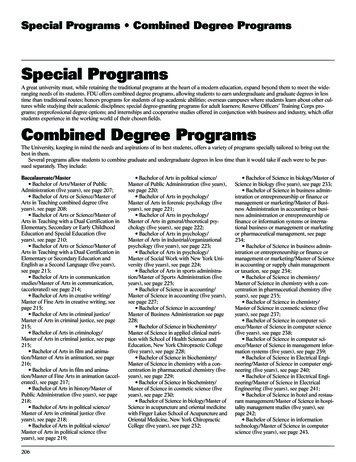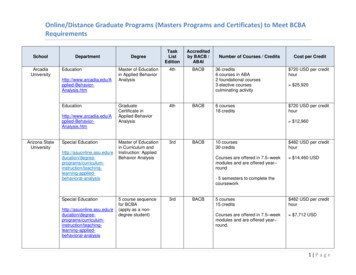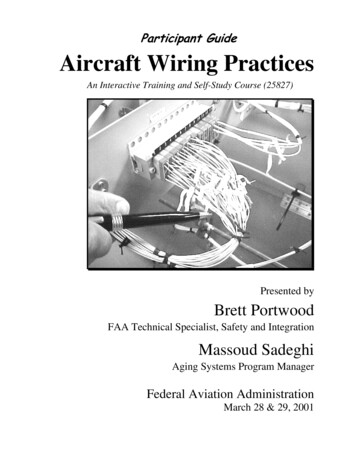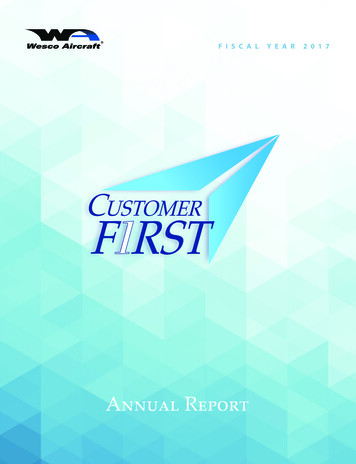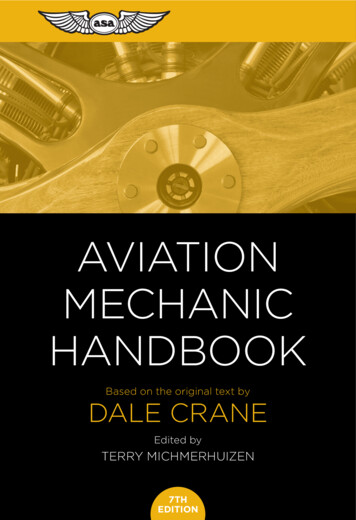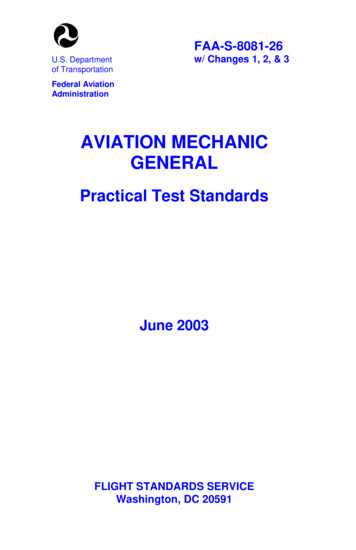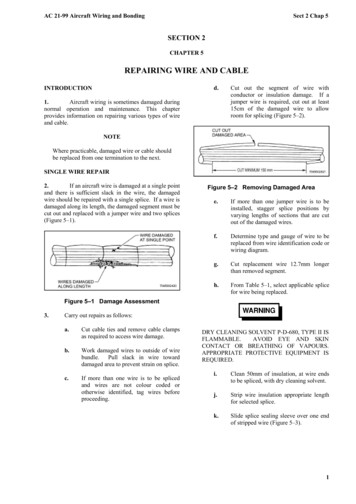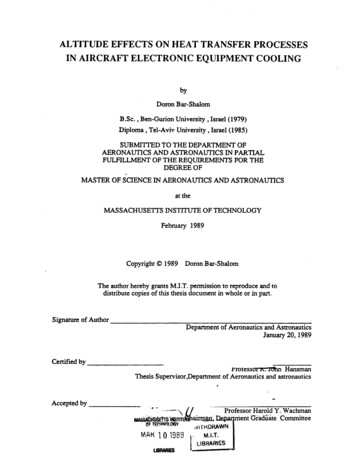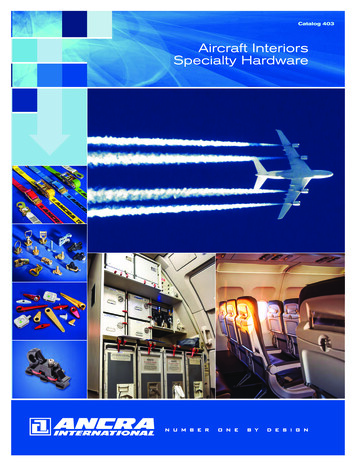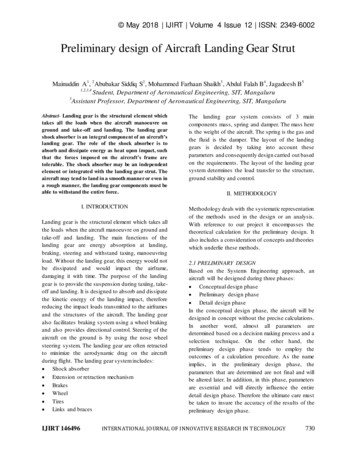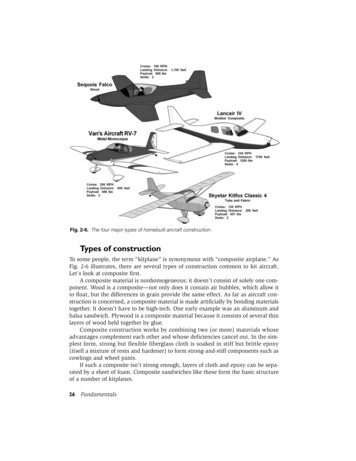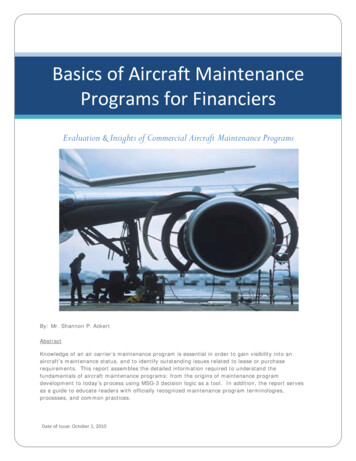
Transcription
Basics of Aircraft Maintenance Programs for FinanciersEvaluation & Insights of Commercial Aircraft Maintenance ProgramsBy: Mr. Shannon P. AckertAbstractKnowledge of an air carrier’s maintenance program is essential in order to gain visibility into anaircraft’s maintenance status, and to identify outstanding issues related to lease or purchaserequirements. This report assembles the detailed information required to understand thefundamentals of aircraft maintenance programs; from the origins of maintenance programdevelopment to today’s process using MSG-3 decision logic as a tool. In addition, the report servesas a guide to educate readers with officially recognized maintenance program terminologies,processes, and common practices.Date of Issue: October 1, 2010
Basics of Aircraft Maintenance Programs for FinanciersEvaluation & Insights of Commercial Aircraft Maintenance ProgramsTABLE OF CONTENTS1.INTRODUCTION . . 22.AIRCRAFT MAINTENANCE PERSPECTIVE . . . . 22.1.Maintenance Program History . . . 22.2.Maintenance Steering Group (MSG) Processes . . 32.2.1. Maintenance Task Development . 62.2.2. Maintenance Program Groupings . 7Basics of Aircraft Maintenance Programs for Financiers 10/1/20103.14.MAINTENANCE PROGRAM DEVELOPMENT . . 73.1.Maintenance Review Board Report (MRBR) Process . . . . 73.1.1. Maintenance Review Board (MRB) 83.1.2. Industry Steering Committee (ISC) . . .83.1.3. Maintenance Working Groups (MWG) . . . .83.2.Policy & Procedures Handbook (PPH) . .83.3.Maintenance Planning Document (MPD) . . .93.3.1. Certification Maintenance Requirements (CMR) .93.3.2. Airworthiness Limitations (AL) .93.4.Operator Aircraft Maintenance Program (OAMP) . . . 93.5.Maintenance Program Supporting Documents . . . 103.6.Maintenance Program Enhancement Process . 113.7.Generic versus Customized Maintenance Program 11MAINTENANCE CHECKS. . . . . . 124.1.Maintenance Letter Checks . . . 124.2.Maintenance Check Packaging . . . 145.MAINTENANCE STORAGE PROGRAM . . . . 156.MAINTENANCE PROGRAM BRIDGING . . . 167.MAINTENANCE PROGRAM – VALUATION PERSPECTIVE . . .178.APPENDIX 1 – EXAMPLE BLOCK & PHASE MAINTENANCE PROGRAM STRUCTURE . 189.APPENDIX 2 – MPD TASK IDENTIFICATION . . . . 1910. APPENDIX 3 – AIRCRAFT STORAGE PROGRAM – TYPICAL ROUTINE TASKS . 2111. REFERENCES . . 2212. ACKOWLEDEMENTS . 22
1.0INTRODUCTIONThe industry definition of maintenance generally includes those tasks required to restore ormaintain an aircraft’s systems, components, and structures in an airworthy condition. Maintenanceis required for three principal reasons:xxx2.0Operational: To keep the aircraft in a serviceable and reliable condition so as to generaterevenue.Value Retention: To maintain the current and future value of the aircraft by minimizingthe physical deterioration of the aircraft throughout its life.Regulatory Requirements: The condition and the maintenance of aircraft are regulated bythe aviation authorities of the jurisdiction in which the aircraft is registered. Suchrequirements establish standards for repair, periodic overhauls, and alteration by requiringthat the owner or operator establish an airworthiness maintenance and inspection programto be carried out by certified individuals qualified to issue an airworthiness certificate.MAINTENANCE PROGRAM PERSPECTIVE2.1 Maintenance Program History - In the early days of aviation maintenance programs weredeveloped primarily by pilots and mechanics. They assessed an aircraft’s needs for maintenancebased on their individual experiences and created programs that were simple and devoid ofanalysis.The introduction of the airlines as a new method of transport demanded new regulations andbroader involvement of the Regulatory Authorities in maintenance requirements. During this eranot only were regulations put in place but programs were started to monitor reliability and safety.Hard-time processes mandated that all components be taken out of service when they reached aspecified age, expressed as the number of operating flight hours, flight cycles, calendar time, orother stress units since new or since last shop visit. Removed units were routed to repair centersand effectively zero-timed, whereby the operating age was restored to a unity of zero by means ofan overhaul.In 1960 representatives from both the FAA and the airlines formed a task force to investigate thecapabilities of preventive maintenance. Two major discoveries resulted from their investigation:1.2.Scheduled overhaul has little effect on the overall reliability of a complex equipment unlessthe equipment has a dominant failure mode, andThere are many items for which there is no effective application for scheduled hard-timemaintenance.Role of MaintenanceThe parts of any mechanical equipment are subject to wear, corrosion, and fatigue which inevitably result in some deviation from the conditions that existed when the equipment was new. Ultimately, the deviations will become great enough that the equipment, or some item on it, no longer meets the required performance standards – that is, it fails. The role of scheduled maintenance is to cope with the failure process. Basics of Aircraft Maintenance Programs for Financiers 10/1/2010The entry of the large jet aircraft (B707 and DC-8) in the fifties focused public attention on theneed for safer and more reliable aircraft. The aircraft manufacturer became the source ofmaintenance program development. Time limitations were established for maintenance and theentire aircraft was periodically disassembled, overhauled, and reassembled in an effort to maintainthe highest level of safety. This was the origin of the first primary maintenance process referred toas Hard-Time (HT).2
The findings of the task force led to the development of a second primary maintenance processdefined as On-Condition (OC). On-Condition requires that an appliance or part be periodicallyinspected or checked against some appropriate physical standard to determine whether it cancontinue in service. The purpose of the standard is to remove the unit from service before failureduring normal operation occurs.Example of an OC process is measurement of brake wear indicator pins; compare brake wearcondition against a specified standard or limit. Brake wear will vary considerably among operatorsdue to operational conditions, however the wear indicator pin on-condition check will help attainnear maximum usage out of each set of brakes.2.2 Maintenance Steering Group (MSG) Processes - In 1968 the Maintenance Steering Group(MSG) was created with a mandate to formulate a decision logic process used for development ofthe initial scheduled maintenance requirements for new aircraft. The group was composed ofparticipants from various aviation bodies, including the Air Transport Association (ATA), airlines,aircraft manufacturers, suppliers, and FAA representatives.That same year representatives of the steering group developed “MSG-1 - Maintenance Evaluationand Program Development", which for the first time used a decision-logic diagram to develop thescheduled maintenance program for the new Boeing 747 aircraft. Both hard-time and on-conditionprocesses were used for development of the aircraft’s routine maintenance tasks – see Figure 1.F IGURE 1- MSG-1 D ECISION L OGICA working paper prepared by the 747 maintenance Steering Group, which advocated the first use of decision logic techniques to develop a scheduledͲmaintenance program. Basics of Aircraft Maintenance Programs for Financiers 10/1/2010MSGͲ1 Maintenance Processes3Aircraft Applications: x747Ͳ100 In 1970, MSG-1 is updated to MSG-2 to make itapplicable for later generation aircraft (L-1011 andDC-10), and at the same time the methodologyintroduces a third primary maintenance processdefined as Condition-Monitoring ons are scheduled to determine integrity orserviceability, however the mechanical performanceHardͲTimeMaintenance is monitored and analyzed. For example, a givenTask & Intervalsoperating characteristic of the equipment indeterioration, etc) is trended and compared withknown “normal” operating levels. An acceptable range is established with either upper and/orlower limits, or some maximum or minimum level. As long as the trend data remain inside theacceptable level, any variation is considered to be normal. When the trend line intersects the“unacceptable” limit, removal of the unit is required to prevent a failure in the future.F IGURE 2- MSG-2 D ECISION L OGICA refinement of the decision logic procedures in MSGͲ1, published in March 1970. MSGͲ2 Maintenance ingAircraft Applications: xDCͲ10 xL1011 xMDͲ80 Maintenance Task & IntervalsA characteristic of CM is that it is not considered apreventive maintenance process; the processallows failures to occur, and the failure modes ofconditioned-monitored items are considered not tohave a direct adverse effect on operating safety.MSG-2 decision logic was subsequently used todevelop scheduled maintenance programs for theaircraft of the 1970s.Maintenance tasks werederived from one of three processes: 1.) HardTime, 2.) On-Condition, and 3.) ConditionMonitoring or some combination of the threeprocesses – see Figure 2.
In 1979 the Air Transport Association (ATA) task force sought to improve on MSG-2 to address anew generation of advanced technology aircraft (B757 & B767). Additionally, the task forceidentified a number of shortcomings in MSG-2 decision logic, key among them:xxxxMSG-2 did not differentiate between maintenance being done for safety reasons versuseconomic reasons.An MSG-2 program became very unwieldy and difficult to manage because it required somany components to be individually tracked.MSG-2 did not effectively deal with the increased complexity of aircraft systems.MSG-2 did not address regulations related to damage tolerance and fatigue evaluation ofstructures; these are currently accounted for in Corrosion Prevention and Control Programs(CPCP) and requirements mandated through an Aging Aircraft maintenance program.The work of the ATA task force led to the development of a new, task-oriented, maintenanceprocess defined as MSG-3. The process adopted a decision tree methodology with the primarypurpose of: a.) separating safety-related items from economic, and b.) defining adequatetreatment of hidden functional failures.Under MSG-3 logic, activities are assessed at the system level rather than the component level –see Figure 3. In other words, if it can be demonstrated that the functional failure of a particularsystem had no effect on operational safety, or that the economic repercussions were notsignificant, there was no need for a routine maintenance activity.F IGURE 3- MSG-2 VS . MSG-3 D ECISION L OGIC P ROCESSThe MSGͲ3 process sorts through functions & failures possibilities of the various components and eliminates all nonͲsignificant items. MSGͲ2 – BottomͲUp ProcessStructuresSystem ASystemsSystem A PowerplantMSGͲ2 did not differentiate between maintenance being done for safety reasons versus economic reasons. The program became difficult to manage because it required so many components to be individually tracked.SubsystemsAssembliesComponentsMSGͲ3 – TopͲDown Process SystemSubsystemsAssembliesSystem A Under MSGͲ3 logic, maintenance tasks are separated into safety and economic categories, and these activities are assessed at the system level rather than the component level. Basics of Aircraft Maintenance Programs for Financiers 10/1/2010Major DivisionComponents4
Although there is no actual in-service operational data available when the MSG-3 process begins for anew aircraft, there is much historical data on the performance of similar components and systemsused in earlier designs, as well as test data from the manufacturer and component vendors. It’s theactual in-service reliability data of similar components and systems that drives the task and intervaldecisions.Another principal benefit from the MSG-3 process is that it generally produces higher safety standards.This is primarily due to the greater degree of intelligent approach to maintenance in terms of selectingtasks that are effective. The approach results in far less maintenance tasks, which minimizes theinfant mortality effect associated with excessive maintenance. Studies in Human Factors clearlyidentified correlation between excessive maintenance and induced incidents, or accidents, resultingfrom preventive maintenance through replacement and overhaul of components.Today, MSG-3 is the only game in town for commercial airplane manufacturers. According to AdvisoryCircular AC-121-22A, FAA policy states that the latest MSG analysis procedures must be used for thedevelopment of routine scheduled maintenance tasks for all new or derivative [Part 121] aircraft. It isthe only methodology accepted by the airworthiness authorities. MSG-3 has also been adopted bymost major business jet manufacturers, with the encouragement of the National Busin
Basics of Aircraft Maintenance Programs for Financiers 10/1/2010 . revenue. xValue Retention: To maintain the current and future value of the aircraft by minimizing the physical deterioration of the aircraft throughout its life. xRegulatory Requirements: The condition and the maintenance of aircraft are regulated by the aviation authorities of the jurisdiction in which the aircraft is .
